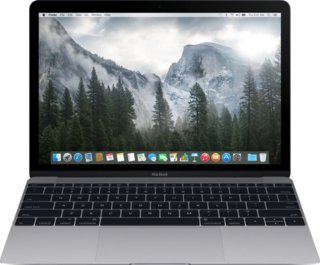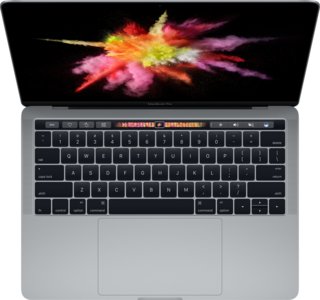Apple MacBook Pro (2015) 15" vs Apple MacBook Pro (2017) 13" with Touch Bar and Touch ID / Intel Core i5 256GB
Hello, tech lovers! This article compares two Macbook heavyweights: the classic 2015 MacBook Pro 15" and its modern relative, the 2017 MacBook Pro 13" with Touch Bar and Touch ID. Both laptops are powerful, but which one really shines? We will examine their design, performance, and distinctive features to provide a comprehensive comparison for your decision-making. Whether you're an Apple enthusiast or simply interested, this guide will help you deeply understand these two strong competitors. Join us as we dive into the innovative technology of Apple and determine which MacBook Pro is deserving of your investment.
System and application performance
Performance in popular 3D games
Viewing angle, color accuracy...
Ports, webcam and other interfaces
Potential battery life
Materials, durability and portability
Design Comparison
Size Comparison
When comparing the design features of the Apple MacBook Pro (2015) 15" and the Apple MacBook Pro (2017) 13" with Touch Bar and Touch ID, distinct features emerge that greatly impact user experience, ergonomics, portability, and aesthetic appeal. Let's explore a comprehensive comparison centering on how these design attributes address varying user requirements.
Design Elements:
Ergonomics:
Size & Weight:
- The MacBook Pro (2015) 15" weighs 4.5 pounds and measures 14.1 x 9.7 x 0.7 inches, providing a generous display but sacrificing portability.
- Conversely, the MacBook Pro (2017) 13" weighs 3 pounds and has dimensions of 12 x 8.4 x 0.6 inches, making it a portable option for students and professionals.
Keyboard & Input:
- The laptops both come with backlit keyboards for better visibility in low-light settings.
- The MacBook Pro (2017) features a Touch Bar that offers dynamic control options specific to different applications, improving user interaction and workflow efficiency.
Materials & Build Quality:
Construction:
- Apple upholds its distinctive high-quality construction using aluminum unibody for both models, guaranteeing resilience and a modern look.
Fingerprint Scanner:
- The MacBook Pro (2017) features Touch ID for secure authentication, offering convenience and enhanced security for users who require fast device access.
Portability & Connectivity:
Port Options: The MacBook Pro (2015) is equipped with standard ports such as USB 3.0 and HDMI to meet the varied connectivity requirements of users.
- In contrast, the MacBook Pro (2017) features USB Type-C ports and Thunderbolt ports for flexible connectivity in a sleek design.
Wireless Capabilities:
- Both laptops support Wi-Fi ac/n standards for fast wireless connectivity.
- Bluetooth versions are slightly updated on the newer model (MacBook Pro 2017), potentially improving compatibility with modern accessories.
Practical Usability & Aesthetic Appeal:
- For Students:
- MacBook Pro (2017) 13": Lightweight design and enhanced portability make it ideal for students moving between classes or study spaces.
- For Professionals:
- MacBook Pro (2015) 15": Larger screen real estate may benefit professionals working on design or multimedia projects requiring detailed visual work.
- MacBook Pro (2017) 13": Touch Bar feature caters to professional users seeking innovative tools and shortcuts for improved productivity.
Conclusion:
In conclusion, the Apple MacBook Pro (2015) 15" is ideal for users needing a larger display and various ports for tasks like multimedia editing. On the other hand, the Apple MacBook Pro (2017) 13" excels in portability, offers modern connectivity with USB Type-C, and includes the innovative Touch Bar for those who value advanced features in a smaller package. The choice between these models should be based on your preferences for screen size, portability, and productivity tools.
Screen Comparison
| Apple MacBook Pro (2015) 15" | Apple MacBook Pro (2017) 13" with Touch Bar and Touch ID Intel Core i5 256GB | |
|---|---|---|
| Resolution | QHD | QHD |
| Screen Size | 15.4" | 13" |
Comparison of Apple MacBook Pro (2015) with a 15" display to Apple MacBook Pro (2017) with a 13" display
When you consider the screens of the Apple MacBook Pro (2015) 15" and the Apple MacBook Pro (2017) 13" with Touch Bar and Touch ID, various key factors influence your user experience, be it for gaming or professional graphic design work.
Screen Size:
- Apple MacBook Pro (2015) 15":
- The 2015 model offers a larger 15.4-inch screen size, allowing for enhanced multitasking and immersive viewing experiences.
- Apple MacBook Pro (2017) 13":
- The 13.3-inch screen on the 2017 model is more compact, making it easier to carry and ideal for users seeking a more portable option.
Resolution:
- Apple MacBook Pro (2015) 15": The display's 2880 x 1800 pixel resolution provides sharp images and text, perfect for detailed tasks such as graphic design.
- Apple MacBook Pro (2017) 13":
- The 2560 x 1440 pixel resolution offers sharp visuals, though it may not match the level of detail seen on the older model's higher-resolution display.
Pixel Density:
- Apple MacBook Pro (2015) 15":
- With a pixel density of 220 pixels per inch (ppi), this laptop provides exceptional clarity and detail for images and text.
- Apple MacBook Pro (2017) 13":
- The laptop screen boasts a pixel density of 227 ppi, resulting in sharp and vibrant images that elevate visual quality.
Display Technology:
- The laptops both have IPS LCD LED displays that provide wide viewing angles and accurate color reproduction. An anti-reflection coating on the Apple MacBook Pro (2015) screen minimizes glare, making it suitable for use in different lighting conditions.
Impact on Gaming:
- The Apple MacBook Pro (2015) offers a more immersive gaming experience with detailed graphics due to its higher resolution and larger screen size. The Apple MacBook Pro (2017) features a compact screen size but delivers crisp visuals with high pixel density, enhancing gaming performance through clear detail display.
Impact on Professional Graphic Design:
Graphic designers may find the Apple MacBook Pro (2015) appealing for its large screen size and high resolution, which enables detailed design work. The Apple MacBook Pro (2017) is a convenient choice for design tasks on the go, offering portability and sharp pixel density that maintains visual quality.
Conclusion:
In conclusion, if you value a larger display with higher resolution for detailed work such as graphic design or immersive gaming experiences, the Apple MacBook Pro (2015) could be a good fit. Conversely, if portability is crucial while ensuring excellent visual clarity for tasks like graphic design or casual gaming, then the Apple MacBook Pro (2017) might be an optimal choice.
Hardware Comparison
| Apple MacBook Pro (2015) 15" | Apple MacBook Pro (2017) 13" with Touch Bar and Touch ID Intel Core i5 256GB | |
|---|---|---|
| RAM | 16GB | 8GB |
| Storage Size | 1000GB | 256GB |
The hardware differences between the Apple MacBook Pro (2015) 15" and the Apple MacBook Pro (2017) 13" with Touch Bar and Touch ID, both equipped with an Intel Core i5 3.1GHz processor, 8GB RAM, and 256GB of storage, influence their performance in multimedia tasks and running intensive software applications.
Apple MacBook Pro (2015) 15"
CPU: The MacBook Pro (2015) features an Intel Core i7 processor running at 4 GHz with 8 threads, making it ideal for resource-intensive activities like video editing and graphic design.
- GPU: Although not stated in the specs, previous versions of this laptop usually included dedicated AMD Radeon graphics cards, providing better performance for applications that require high-quality graphics.
- RAM: Offering 16GB of RAM at a speed of 1600 MHz, this model excels in multitasking, ensuring smooth performance with multiple programs running simultaneously.
Performance Impact: With its powerful CPU and generous RAM, the MacBook Pro (2015) is ideal for handling demanding tasks such as video editing, gaming, and running virtual machines with minimal latency.
Apple MacBook Pro (2017) 13" with Touch Bar and Touch ID
- CPU: The newer MacBook Pro (2017) features an Intel Core i5 processor running at 3.1GHz with 4 threads, delivering dependable performance for daily computing tasks. GPU: The specific details about the GPU are not available, but the integrated Intel Iris Plus Graphics provide satisfactory performance for light to moderate graphics tasks, similar to the previous model.
- RAM: This model features 8GB of RAM at a faster speed of 2133 MHz, ensuring snappy responsiveness during multitasking and smoother operation when handling multiple browser tabs or productivity apps.
Performance Impact: The MacBook Pro (2017) shines in everyday tasks such as web browsing, document editing, and light photo editing, thanks to its powerful CPU and enhanced RAM speed.
Comparison Summary
- CPU Performance: The older MacBook Pro (2015) provides better processing power than the newer MacBook Pro (2017), making it more suitable for demanding tasks.
- RAM Speed & Capacity: The newer model boasts faster RAM speed of 2133 MHz, while the older model's 16GB capacity excels in multitasking.
- Storage: The latest model comes with flash storage for faster read/write speeds, albeit with a reduced storage capacity compared to its predecessor.
In conclusion: When high-performance computing is needed for heavy-duty tasks such as video editing or gaming, the Apple MacBook Pro (2015) stands out with its strong CPU and generous RAM. However, if you value ease of transportation and daily productivity with enhanced multitasking capabilities, the Apple MacBook Pro (2017) could be a better fit.
Battery Comparison
| Apple MacBook Pro (2015) 15" | Apple MacBook Pro (2017) 13" with Touch Bar and Touch ID Intel Core i5 256GB | |
|---|---|---|
| Battery Life | 9 hours | 10 hours |
When comparing the battery performance of the Apple MacBook Pro (2015) 15" with the Apple MacBook Pro (2017) 13" with Touch Bar and Touch ID, there are some notable differences to consider:
Apple MacBook Pro (2015) 15":
- Battery Life: Provides a solid 9 hours of battery life, ensuring you can easily go through a standard workday or enjoy entertainment without interruptions.
- Battery Power: The 6600 mAh battery ensures ample power for sustained usage, reducing the need for frequent recharging.
- Magsafe Power Adapter: The Magsafe power adapter provides a convenient and secure way to connect and charge your device.
Apple MacBook Pro (2017) 13" with Touch Bar and Touch ID:
- Battery Life: Features an enhanced battery life lasting up to 10 hours, providing extended usage time in comparison to its previous version.
- Design: The 13" model's compact size and lightweight build make it highly portable, catering to users needing extended battery life while on the move.
The Apple MacBook Pro (2017) 13" surpasses the older MacBook Pro (2015) 15" in battery life by up to an hour on a single charge, benefiting users with high laptop usage during the day. If longer battery life is essential for you, consider the Apple MacBook Pro (2017) 13" with Touch Bar and Touch ID. Alternatively, if you prioritize different features or size options, the Apple MacBook Pro (2015) 15" remains a dependable choice.
Verdict
Why Apple MacBook Pro (2015) 15"?
- Larger screen size providing more screen real estate for multitasking and immersive experiences.
- Additional ports for enhanced connectivity and versatility in professional settings.
- Robust performance capabilities suitable for resource-intensive tasks like graphic design and gaming.
Why ?
- Enhanced portability with a lighter and more compact design.
- Modern features like Touch Bar and Touch ID for improved user experience.
- Updated connectivity options with USB Type-C ports.
- Longer battery life for extended usability on a single charge.
Similar comparisons
- Apple MacBook Pro (2015) 15" vs Apple MacBook Pro (2016) 13"
- Apple MacBook Pro (2015) 13" vs Apple MacBook Pro (2015) 15"
- Apple MacBook Pro (2015) 13" vs Apple MacBook Pro (2017) 13" with Touch Bar and Touch ID / Intel Core i5 256GB
- Apple MacBook Air (2020) 13.3" Intel Core i3 vs Apple MacBook Pro (2017) 13" with Touch Bar and Touch ID / Intel Core i5 256GB
- Apple MacBook Pro (2015) 13" vs Microsoft Surface Pro 6

